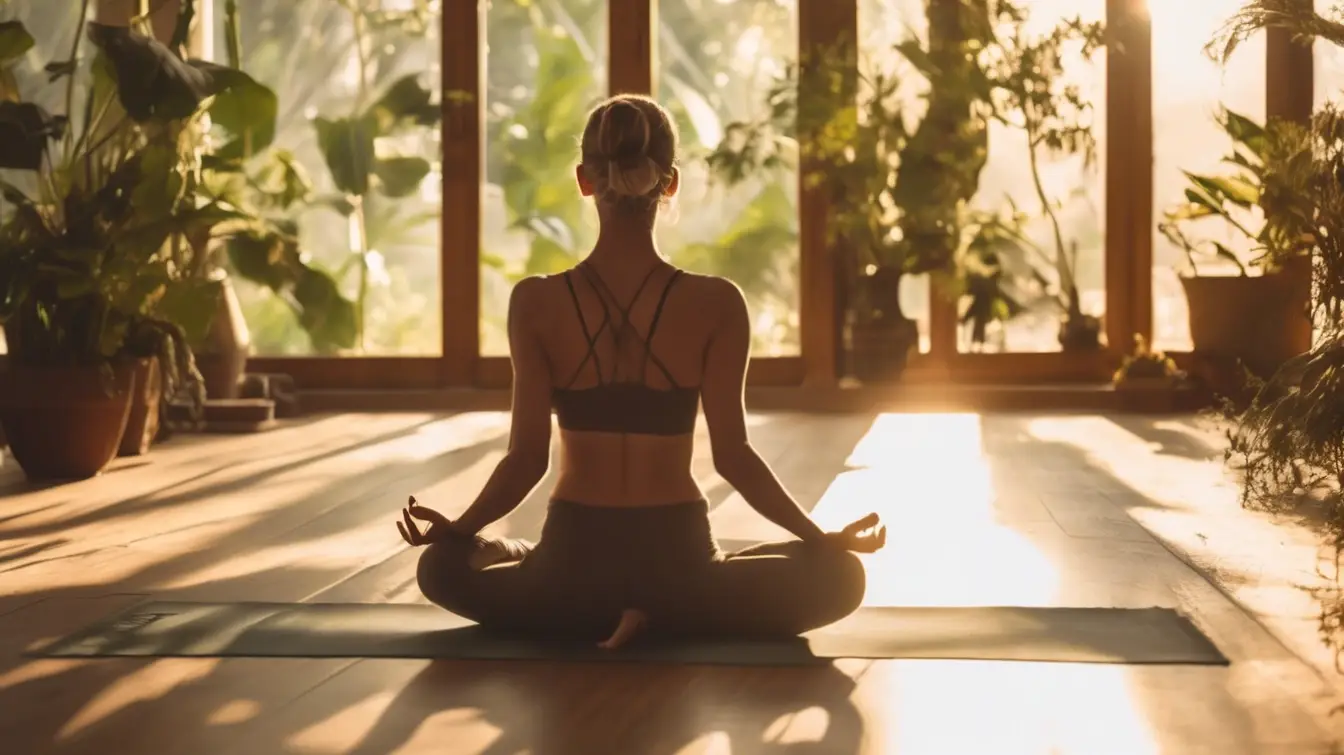Surya Namaskar: 12 energetic moves to boost strength, flexibility, and vitality. Unlock the true power of Sun Salutation!
Surya Namaskar: 12 Energizing Moves for a Stronger You
What if a single yoga sequence could strengthen your body, calm your mind, and energize your entire day? The ancient sun salutation sequence does exactly that—blending movement, breath, and mindfulness into one powerful practice.
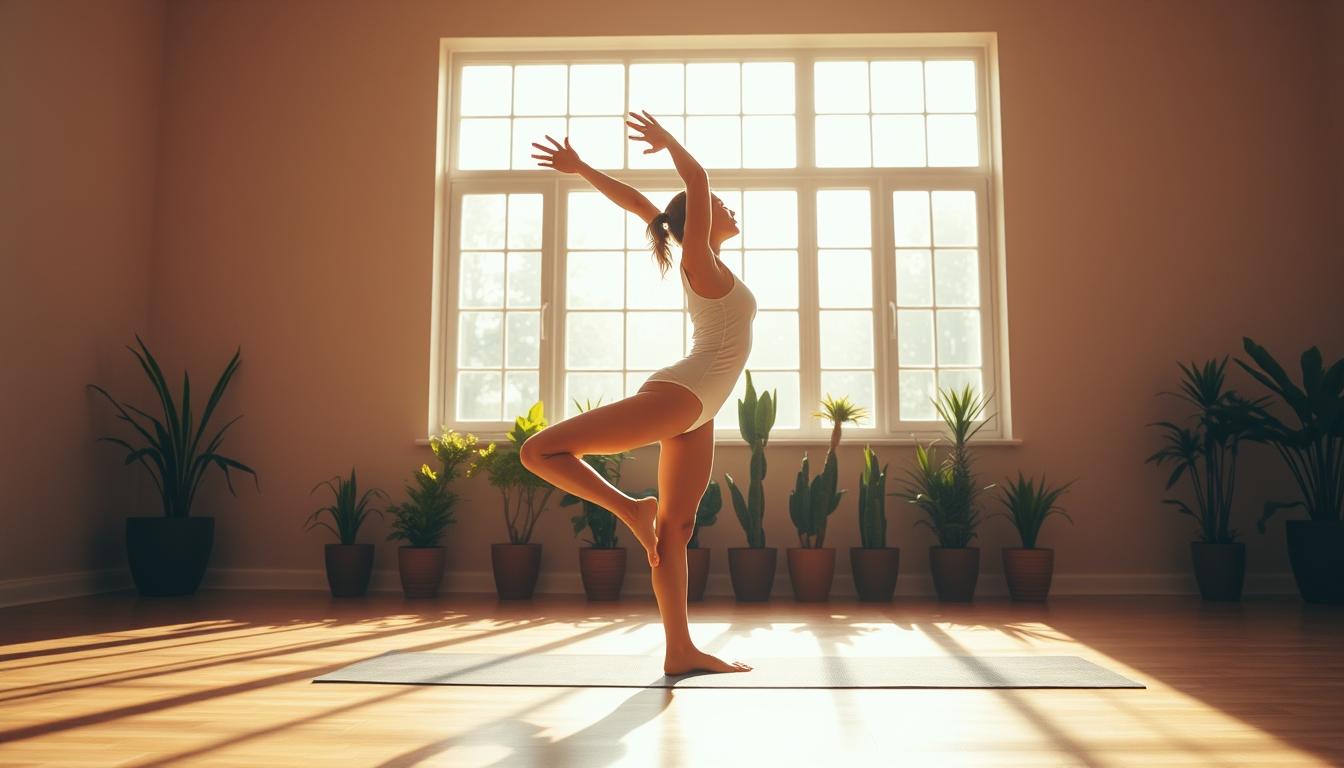
Surya Namaskar
Originating from Vedic traditions, this 12-pose flow was modernized by yoga master Krishnamacharya. It’s more than exercise—it’s a moving meditation that connects you to rhythm and awareness. Gurudev Sri Sri Ravi Shankar recommends pairing it with Yoga Nidra for deeper relaxation.
Whether you’re new to yoga or a seasoned practitioner, this guide breaks down each step. You’ll discover its history, benefits, and adaptable modifications for every fitness level.
Key Takeaways
- 12-pose sequence combining physical and spiritual elements
- Rooted in ancient traditions, adapted for modern practice
- Enhances both cardiovascular health and mental focus
- Recommended with Yoga Nidra for full-body relaxation
- Customizable for beginners and advanced practitioners
What Is Surya Namaskar?
Ancient yogis developed a ritual that blends breath, motion, and reverence. This practice, now known as sun salutations, began as a Vedic tribute to solar energy over 5,000 years ago. Originally, it involved 132 mantras and full-body prostrations—a prayer in motion.
https://youtube.com/watch?v=_ENYL8qxKx0%3Frel%3D0
The Origins and Spiritual Significance
In Vedic traditions, the sun symbolized consciousness and vitality. Early practitioners recited the Gayatri mantra during movements aligning the spine with cosmic rhythms. Scholar Christopher Key Chapple notes this was a four-directional ritual—honoring earth, sky, and the sun’s cyclical journey.
By the 1930s, Krishnamacharya adapted wrestling exercises into a fluid sequence. His book Yoga Makaranda documented these poses, merging physical rigor with meditation. Ashtanga and Iyengar schools later refined the flow for Western practitioners.
“The sun salutation is an ecstatic life force experience—connecting individual energy to the universe.”
—Shiva Rea, Prana Flow Yoga
Modern Adaptations
Today’s variations balance tradition and accessibility. Pattabhi Jois emphasized dynamic transitions, while Iyengar focused on alignment. Below compares key styles:
| Style | Focus | Key Innovator |
| Ashtanga | Speed and stamina | Pattabhi Jois |
| Iyengar | Precision with props | B.K.S. Iyengar |
| Prana Flow | Creative movement | Shiva Rea |
Mysore Palace once used this sequence for athletic training. Now, it’s a global yoga staple—uniting strength, flexibility, and mindful prayer in one seamless flow.
Benefits of Practicing Surya Namaskar
Science confirms what yogis knew: this practice boosts heart health and mental focus. Each movement engages your body while harmonizing breath and awareness. Research reveals measurable improvements in strength, flexibility, and emotional balance.

A serene, sunlit yoga studio with warm, golden light streaming through large windows. In the foreground, a person performing the sun salutation (Surya Namaskar) pose, their body elongated and balanced, exuding a sense of focus and tranquility. The middle ground features additional practitioners mirroring the pose, each at different stages of the sequence. The background showcases lush, verdant plants and natural elements, creating a calming, nurturing atmosphere. The overall scene radiates the physical, mental, and spiritual benefits of this ancient practice, inviting the viewer to explore the transformative power of Surya Namaskar.
Cardiovascular and Muscular Health
A 150-pound person burns 416 calories per hour—equivalent to moderate cycling. The flow activates every muscle group, from fingers to toes. Studies show:
- 12% increase in HDL cholesterol with daily practice
- 23% flexibility gains in 8 weeks (2018 NIH study)
- Enhanced lymphatic drainage and spinal nerve stimulation
B.K.S. Iyengar documented its therapeutic effects for arthritis. The sequential bending and arching also activate chakras, aligning physical and energetic systems.
Mental Clarity and Stress Relief
Loyola Marymount University found it reduces cortisol by 27%. The vagus nerve stimulation triggers relaxation responses. Benefits extend to:
- Sharper proprioception (balance/coordination)
- Respiratory toning for deeper breaths
- Ayurvedic dinacharya (ideal morning routine)
This isn’t just exercise—it’s a moving meditation that resets your mind and body.
Preparing for Your Practice
Before diving into the sequence, proper preparation enhances both safety and results. A thoughtful warm-up primes your body and sharpens focus, making each movement more effective. Below, we outline essential steps to optimize your routine.
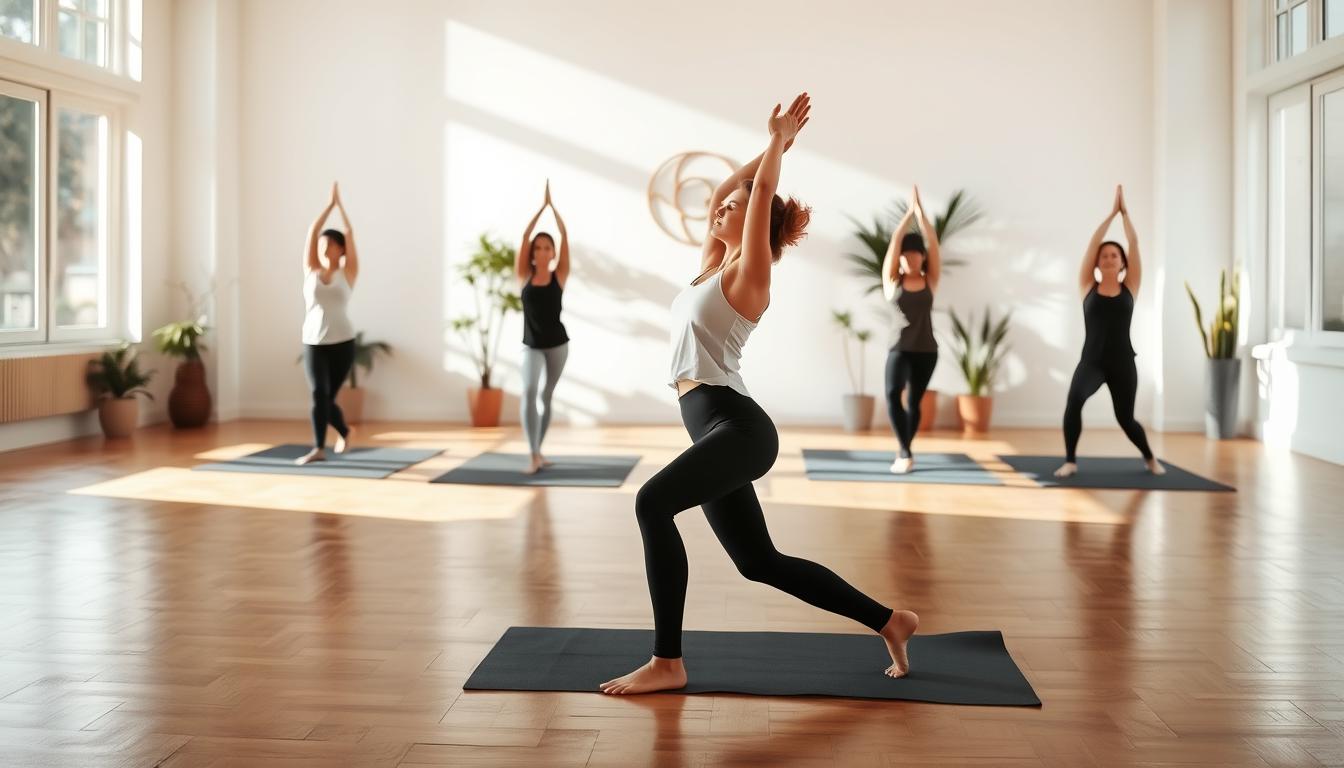
A serene yoga studio with natural light streaming through large windows. In the foreground, a woman in a white top and black leggings gracefully moves through a series of warm-up poses – starting with a standing forward fold, transitioning to a downward-facing dog, and then flowing into a low lunge. Her movements are fluid and focused, conveying a sense of inner calm. The middle ground features additional yoga practitioners mirroring her pose sequence, their bodies casting long shadows across the hardwood floor. In the background, potted plants and a minimalist wall decor create a tranquil, nature-inspired atmosphere.
5-Step Warm-Up Flow
Start with this gentle progression to awaken muscles and joints:
- Balasana (Child’s Pose): Kneel with hips back, stretching arms forward to release tension.
- Cat-Cow Stretch: Move between arched and rounded spine positions to lubricate vertebrae.
- Adho Mukha Svanasana (Down Dog): Press hands and feet into the mat, lifting hips for hamstring lengthening.
- Shoulder Circles: Roll shoulders forward/backward 10 times to improve mobility.
- Hip Openers: Sit cross-legged and gently bend knees, rocking side to side.
“Practicing outdoors at sunrise aligns your rhythm with nature’s energy—just avoid cold surfaces to prevent muscle strain.”
—Shiva Rea
Breathing and Timing Tips
Use ujjayi breath (3:1 exhale-to-inhale ratio) to oxygenate muscles. Key considerations:
- Practice on an empty stomach—wait 3+ hours after meals.
- Room temperature: 75–80°F to prevent stiffness.
- Use a yoga wedge under hands if wrists feel strained.
| Time of Day | Benefits | Modifications |
| Morning | Boosts energy, aligns with circadian rhythms | Add extra hip openers for stiffness |
| Evening | Releases tension, prepares for sleep | Reduce intensity; focus on breath |
Cold muscles risk injury—always warm up before deep stretches. Whether at dawn or dusk, these steps ensure a fluid, mindful practice.
Step-by-Step Guide to Surya Namaskar
Mastering this sequence begins with understanding each posture’s alignment. Below, we break down the first two poses with precise cues for hands, arms, and breath synchronization. Hold each for 5 seconds as a beginner, gradually deepening your practice.
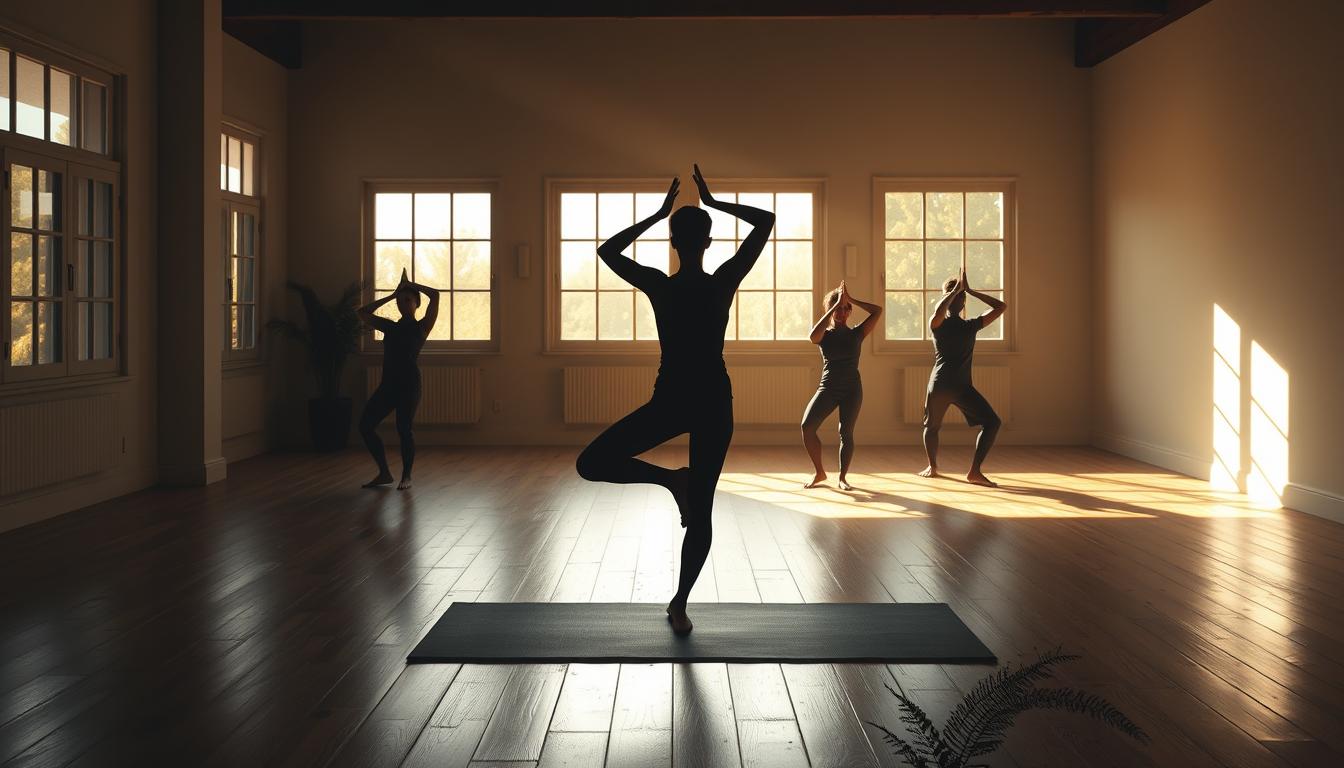
A serene, dimly-lit studio setting with a wood-paneled floor and minimalist decor. Sunlight streams in from large windows, casting a warm, natural glow. In the center, a yogi demonstrates the steps of the sun salutation (Surya Namaskar) sequence, their silhouette in perfect form. The poses are shown sequentially, with each transitional movement captured in graceful, flowing lines. The figure is surrounded by delicate botanical elements, like ferns and wildflowers, that add a sense of tranquility. The overall atmosphere is one of peaceful focus and mindful practice.
Pose 1: Pranamasana (Prayer Pose)
Start standing tall with feet hip-width apart. Press your palms together at the chest, thumbs lightly touching the sternum. Distribute weight evenly across both feet to ground yourself.
- Alignment: Engage your core to avoid arching the back. Relax shoulders away from ears.
- Breath: Inhale deeply through the nose, expanding the chest.
- Common Error: Clenching hands tightly—keep fingers relaxed.
Pose 2: Hastauttanasana (Raised Arms Pose)
From Prayer Pose, inhale and sweep your arms overhead. Keep palms together or shoulder-width apart if tight. Lift the ribcage without compressing the lower back.
| Focus Area | Action | Modification |
| Shoulders | Roll them down and back | Use a strap between hands if stiff |
| Feet | Press all four corners into the floor | Place a block under heels if needed |
“Initiate movement from the ribcage, not just the arms, to protect the lumbar spine.”
—Yoga Journal
Variations and Modifications
Adapting the sequence to your body’s needs unlocks its full potential. Whether you’re working with tight muscles or aiming for advanced transitions, these adjustments ensure safety and progress. Below, explore tailored options for every level.
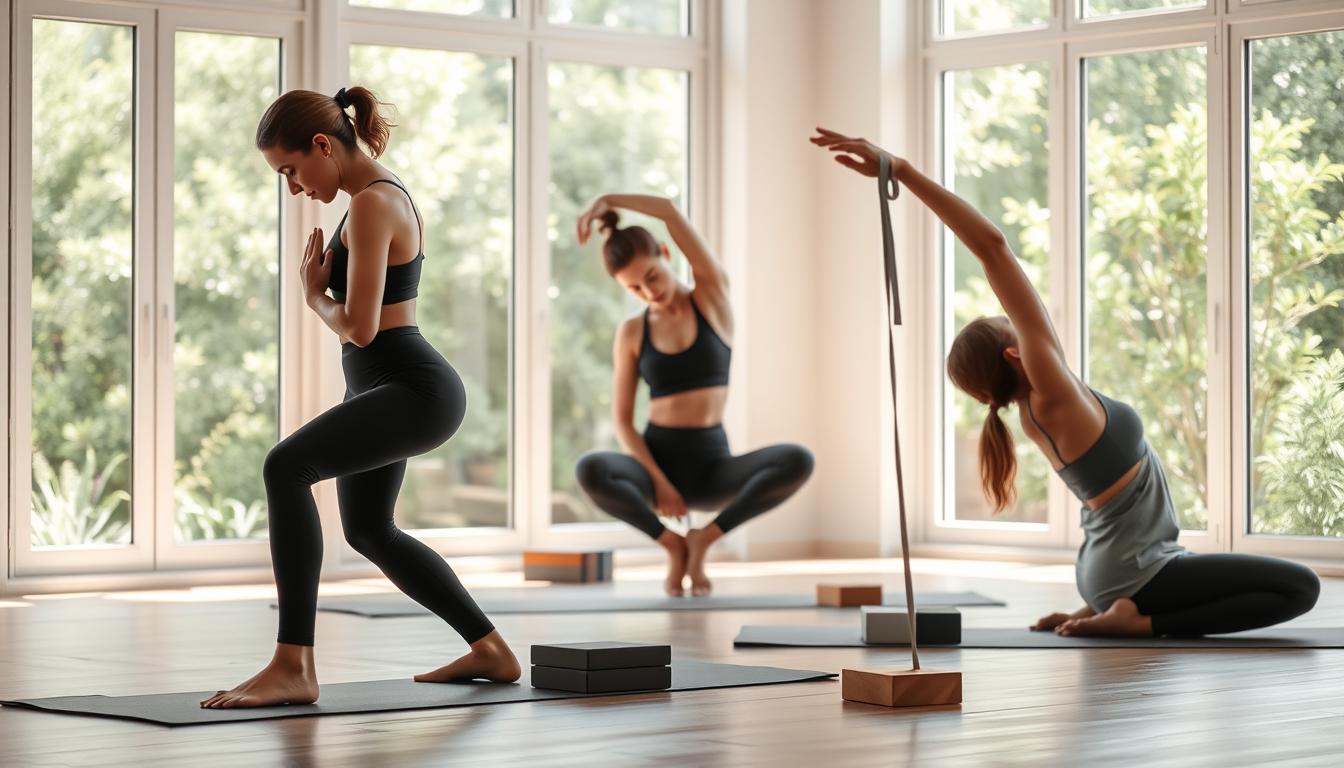
A serene, well-lit yoga studio with natural light streaming through large windows. In the foreground, a person demonstrating various yoga modifications to improve flexibility – a forward fold with bent knees, a seated straddle stretch, and a reclined twist. The subject is dressed in comfortable, form-fitting athletic wear, their movements graceful and purposeful. The middle ground showcases props like blocks and straps, conveying a sense of guidance and support. The background features lush, calming greenery, creating a peaceful, rejuvenating atmosphere.
For Tight Hamstrings or Wrists
Stiffness shouldn’t stop your practice. Try these modifications:
- Chair Yoga: Sit tall, placing your left foot on a block. Lean into a gentle forward bend with hands on thighs.
- Strap-Assisted Uttanasana: Loop a strap around your knees to ease tension in the hamstrings.
- Dolphin Pose: Rest on forearms instead of hands to relieve wrist pressure.
| Modification | Benefit | Best For |
| Iyengar Rope Wall | Supports spinal alignment | Chronic back pain |
| Bent knees in Uttanasana | Reduces hamstring strain | Beginner practitioners |
Advanced Variations
Challenge your practice with these dynamic options:
- Wall Handstand: Kick into a handstand against a wall, then lower into Chaturanga.
- Partner Backbends: Have a spotter support your Wheel Pose for deeper arches.
- Plyometric Jumps: Add explosive movement between poses for power yoga intensity.
“Advanced practitioners should prioritize control over speed—especially in inversions.”
—Yoga International
For prenatal modifications, widen your stance and avoid deep twists. Always listen to your body—progress comes with patience.
Conclusion
91% of practitioners stick with it—here’s why you should too. This 12-round sun salutation strengthens body and calms the mind, with a 91% retention rate for 30-day challengers.
Start with one round, then gradually increase. Pair it with pranayama or Yoga Nidra for deeper effects. Track progress in a journal—even 108 rounds is achievable.
Join local classes or online communities for motivation. Adjust intensity seasonally: slower in winter, vibrant in summer.
Master this practice, and watch your days transform. Roll out your mat tomorrow—your stronger self awaits.
FAQ
What is the best time to practice Surya Namaskar?
Early morning is ideal, as it energizes your body and mind. However, you can practice anytime on an empty stomach for maximum benefits.
How many rounds should beginners start with?
Start with 2-3 rounds, gradually increasing to 10-12 as your stamina improves. Focus on breath and movement coordination.
Can I modify poses if I have tight hamstrings?
Yes! Bend your knees slightly in forward bends or use props like blocks. Listen to your body and avoid strain.
Does Surya Namaskar help with weight loss?
Yes, it boosts metabolism and burns calories when practiced consistently. Pair it with a balanced diet for best results.
What’s the role of breathing in the sequence?
Each movement syncs with inhales or exhales to enhance oxygen flow and focus. Proper breathing deepens the practice.
Are there advanced variations for experienced practitioners?
Absolutely! Try adding poses like Chaturanga Dandasana or holding postures longer to intensify the challenge.
Can I practice with an injury?
Consult a yoga therapist first. Modify or skip poses that stress injured areas—safety always comes first.
Share this content:

